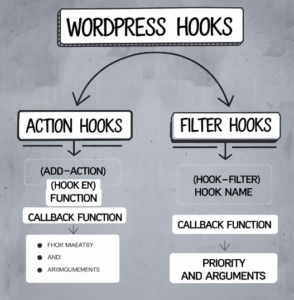“The Ultimate Guide to WordPress: Features, Functionality, and Best Practices”
Introduction
WordPress is one of the most popular content management systems (CMS) available today, powering over 40% of websites on the internet. It began as a simple blogging platform but has since evolved into a versatile tool for building various types of websites, from personal blogs to large e-commerce stores. This article will walk you through how WordPress works, explain the concept of WordPress hooks, and offer insights into themes and web design. We’ll also answer common questions like “What WordPress theme is that?” and provide tips on using WordPress effectively.
How WordPress Works
Understanding how WordPress operates behind the scenes can enhance your ability to manage and customize your site effectively. Here’s a simplified overview of the WordPress workflow:

- Loading Configuration Files: When you visit a WordPress site, it first loads the wp-config.php file. This file contains essential settings and database information necessary for WordPress to function properly.
- Setting Up Constants: WordPress then sets up default constants such as upload locations and file size limits.
- Loading Caching and Database Files: Next, WordPress checks for files like advanced-cache.php and db.php, which help with performance optimization and database management.
- Connecting to the Database: WordPress connects to your MySQL database to retrieve and store site information. If it can’t connect, it will display an error message.
- Loading Additional Files: The system continues by loading files for caching, localization (for different languages), and multisite network settings if applicable.
- Initializing Plugins and Themes: WordPress loads active plugins and theme functions, which allow for custom features and design elements.
- Setting Up Query Objects: WordPress prepares objects for handling queries and rewriting URLs to display the correct content.
- Running Actions and Queries: Actions are executed to run code from plugins and themes. WordPress processes user requests, performs queries, and fetches content from the database.
- Displaying Content: Finally, WordPress compiles the requested content, applies filters, and displays the page to the user.
Understanding WordPress Hooks
WordPress hooks are a critical part of how the platform operates, enabling developers to customize and extend its functionality. There are two main types of hooks:

Action Hooks: These allow you to add custom code at specific points during the WordPress execution process. For example, you might use an action hook to insert custom HTML or run additional functions when a post is published.
Filter Hooks: Filters enable you to modify data before it is displayed on the site. For instance, you could use a filter hook to change the text of a specific WordPress message or modify the output of a query.
Hooks provide a way to interact with WordPress without altering the core code, making it easier to update and maintain your site.
What WordPress Theme Is That?
Identifying the theme used by a WordPress site can be useful if you want to replicate a similar design. Here’s how you can find out:
- Check the Source Code: Right-click on the webpage and select “View Page Source.” Look for a link to the theme’s CSS file, which often contains the theme’s name.
- Use Online Tools: Websites like What WordPress Theme Is That? can automatically detect the theme and plugins used on a site.
- Inspect the Site: If you have access to the site’s WordPress dashboard, go to Appearance > Themes to see the active theme.
WordPress Web Design
When designing a WordPress site, choosing the right theme and customizing it effectively are crucial for achieving the desired look and functionality. Here are some tips for WordPress web design:
- Select a Responsive Theme: Ensure your theme is mobile-friendly and adapts to different screen sizes.
- Customize with Page Builders: Tools like Elementor and Divi allow you to design pages with drag-and-drop functionality, making it easy to create a unique layout.
- Optimize for Performance: Use caching plugins, optimize images, and choose a reliable hosting provider to improve site speed.
- Focus on User Experience: Ensure easy navigation, clear calls-to-action, and a visually appealing design to enhance user engagement.
Common Questions and Solutions
- What Size Image to Use on WordPress?: For optimal performance, use images that are appropriately sized for their display context. Typically, images should be 72 DPI for web use, with dimensions adjusted to fit the theme’s design. Compress images to reduce file size without sacrificing quality.
- Can a SIEM Be Used to Monitor a WordPress Site?: Yes, a Security Information and Event Management (SIEM) system can monitor WordPress sites by tracking and analyzing security logs, detecting potential threats, and alerting you to suspicious activities.
- How to Use Keywords in WordPress to Improve Ranking: Use SEO plugins like Yoast SEO to optimize your site’s content. Incorporate relevant keywords naturally into your posts, titles, meta descriptions, and headings to improve search engine rankings.
- Using Nessus to Scan a WordPress Site: Nessus is a vulnerability scanner that can be used to identify security issues on a WordPress site. Perform scans regularly to detect and address potential vulnerabilities.
- What’s a Bold News Font Style Used in WordPress?: Popular bold fonts for news sites include “Bebas Neue” and “Montserrat.” These fonts are eye-catching and suitable for headlines and important text.
Conclusion
WordPress is a powerful and versatile platform that can cater to a wide range of website needs. Understanding how it works, utilizing WordPress hooks, and choosing the right theme are essential for building and managing a successful site. With the right knowledge and tools, you can leverage WordPress to create a dynamic and engaging online presence.
Additional Resources and Contact Information
For those looking to dive deeper into WordPress or needing personalized assistance, we’re here to help.
Contact Us:
-
Email: support@mycodelive.com
-
Visit: https://mycodelive.com/
